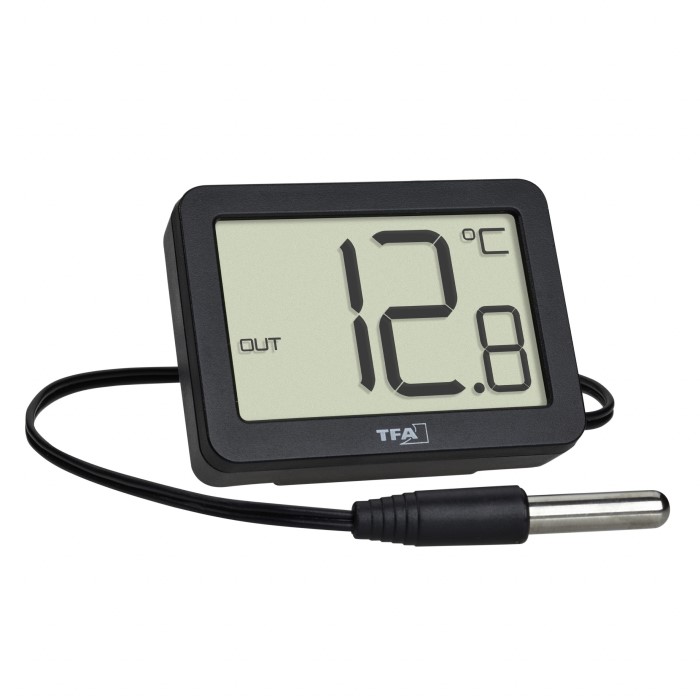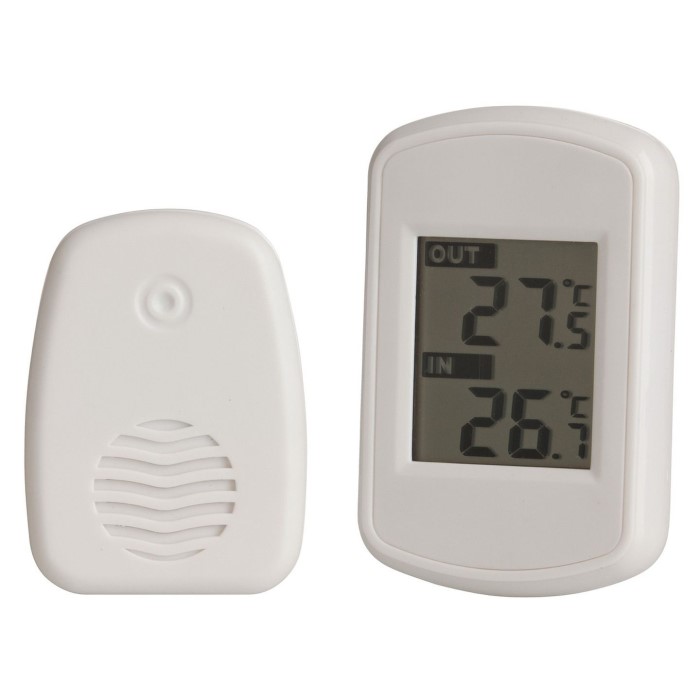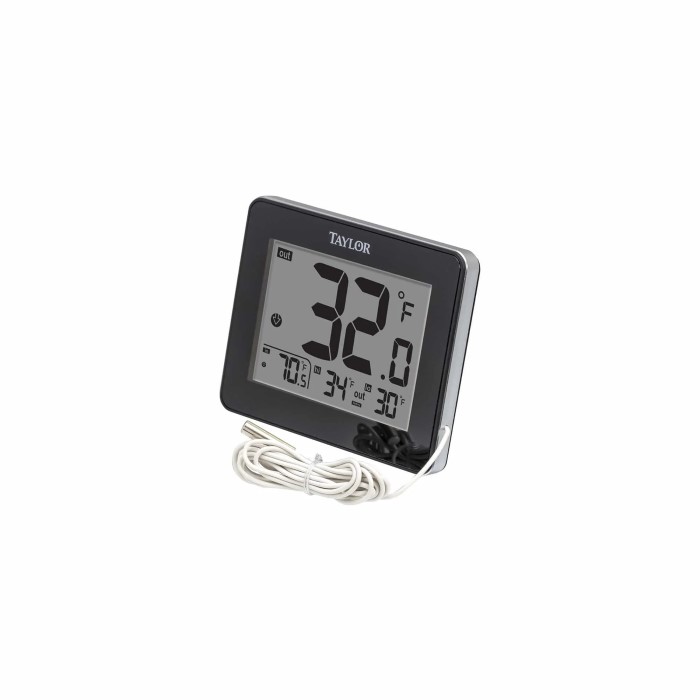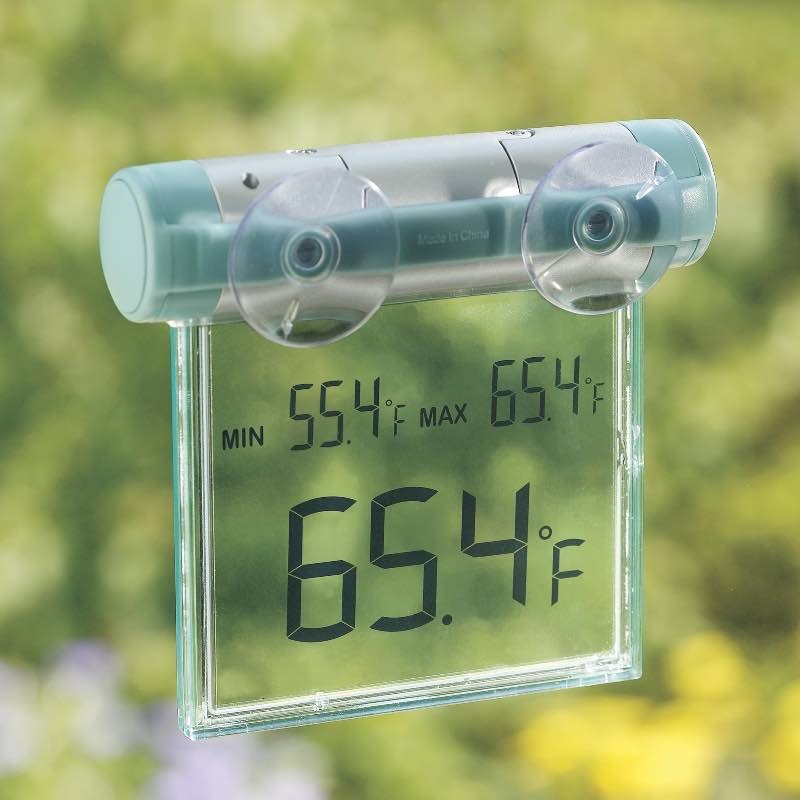What Is a Digital Outdoor Thermometer?
A digital outdoor thermometer measures and displays the outdoor temperature using advanced electronic sensors. Unlike traditional analog models, it offers precise readings and often comes with additional features. These thermometers are designed to be easy to read, user-friendly, and functional in various weather conditions. They are commonly used to monitor outdoor settings like backyards, gardens, or patios.
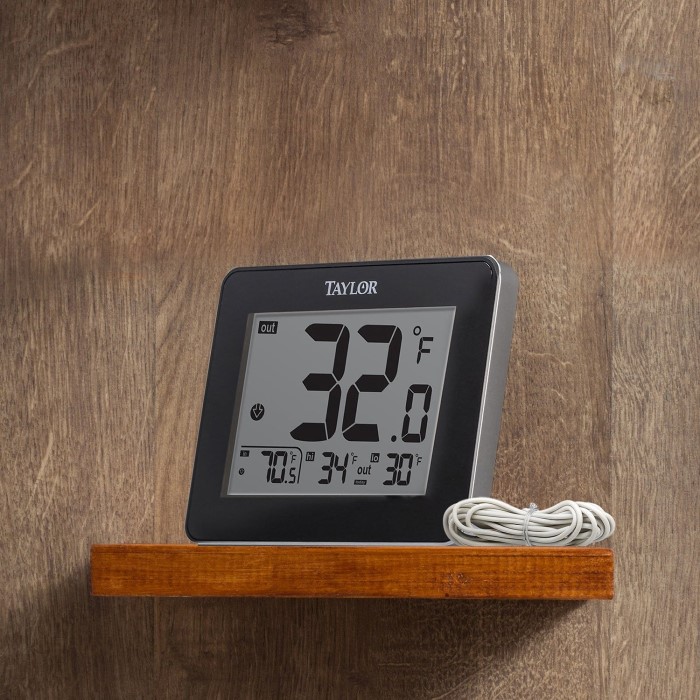
Key Features of Digital Thermometers
Digital outdoor thermometers come with a variety of modern features that enhance usability:
- High Accuracy – Advanced sensors ensure reliable temperature readings.
- Clear Display – Bright LCD or LED screens make it easy to read the temperature.
- Temperature Memory – Many devices can record and show historical temperature data.
- Multiple Units – The option to switch between Celsius and Fahrenheit is common.
- Additional Measurements – Some models include features like humidity tracking or weather trends.
Advantages Over Analog Thermometers
Digital thermometers outshine analog ones in several areas:
- Better Readability – Digital displays are clearer and often backlit, great for low-light settings.
- Higher Accuracy – Digital sensors are less prone to error compared to traditional mercury-based designs.
- Advanced Functionality – They offer additional features, such as wireless connectivity or weather alerts.
- Ease of Use – No interpretation of complex scales; simply read the displayed number.
- Modern Design – Digital thermometers often come in sleek and compact designs, fitting any décor.
Using a digital outdoor thermometer helps you keep track of weather conditions more efficiently and accurately.
Types
Digital outdoor thermometers come in various types to suit different needs. Each type offers unique features and benefits to enhance your monitoring experience. Understanding these types helps you choose the best thermometer for your outdoor spaces.
Wireless Thermometers
Wireless thermometers rely on radio frequency or Bluetooth to transmit temperature data. They eliminate the need for tangled wires and physical connections. These thermometers allow you to monitor outdoor readings from the comfort of your home. Many include additional features like remote sensors for tracking temperatures in multiple locations.
Advantages of wireless thermometers:
- Convenience: Access readings remotely on a display indoors.
- Multi-location monitoring: Use multiple sensors for different outdoor areas.
- User-friendly configuration: Easy installation and flexible placement, thanks to their wireless design.
Thermometers with Hygrometers
Thermometers with hygrometers track both temperature and humidity levels. These models are perfect for gardening or managing outdoor conditions. By monitoring humidity, they help you ensure the right climate for plants or predict weather changes.
Benefits of thermometers with hygrometers:
- Dual measurements: Accurate data for temperature and humidity.
- Enhanced weather tracking: Ideal for planning outdoor activities.
- Gardening assistance: Keep plants in optimal conditions with precise humidity monitoring.
Solar-Powered Thermometers
Solar-powered thermometers use energy from sunlight to operate. They are environmentally friendly and cost-effective. These thermometers work well in sunny areas and reduce the need for batteries or electrical power.
Why solar-powered thermometers are a good choice:
- Eco-friendly: Utilize renewable solar energy for functionality.
- Cost-saving: No need to replace batteries frequently.
- Long-lasting performance: Durable designs to withstand direct sunlight and various weather conditions.
Choosing the right type of digital outdoor thermometer ensures optimal functionality tailored to your specific needs.
Factors to Consider When Selecting a Digital Outdoor Thermometer
Choosing a digital outdoor thermometer requires careful consideration of several key factors. These factors ensure you select a thermometer that meets your needs and stands the test of time.
Accuracy and Reliability
High accuracy is crucial for reliable temperature readings. Look for devices with advanced sensors that minimize errors. Reliable thermometers often come with certifications for precision standards. Consistent performance in various weather conditions is also a key attribute.
Display and Readability
A clear, easy-to-read display is essential for quick temperature checks. Opt for thermometers with LCD or LED screens that are bright and visible in different lighting conditions. Backlit displays provide additional readability during nighttime or in shade. Large fonts and simple layouts improve user experience.
Durability and Weather Resistance
Outdoor thermometers need to withstand changing weather conditions. Choose models made from weather-resistant materials like durable plastics or stainless steel. Ensure your thermometer is waterproof, rust-proof, and UV-resistant, especially for prolonged outdoor use. Robust designs can handle extreme temperatures and humidity.
Range of Measurement
Thermometers differ in their measurement ranges. Select a model that suits your region’s climate. Wide measurement ranges are helpful for extreme cold or heat. If you require humidity tracking, pick a thermometer that includes hygrometer features.
By considering these factors, you will find the ideal digital outdoor thermometer for your needs.
Installation and Placement Tips
Proper installation and placement of your digital outdoor thermometer ensure accurate readings and long-lasting performance. By choosing the right location and avoiding common mistakes, you can maximize its functionality.
Ideal Locations for Thermometer Placement
Selecting the ideal location is key to reliable measurements. Consider these placement tips:
- Shade or Partial Cover: Place your thermometer in a shaded area. This prevents direct sunlight, which may cause inaccurate readings.
- Away from Heat Sources: Keep it away from heat-producing objects like air conditioners or grills to avoid distorted results.
- Airflow Accessibility: Install it in open areas with good airflow for more precise temperature data.
- Stable Mounting Surface: Ensure the thermometer is mounted on a steady surface. This prevents it from shifting or falling.
- Optimal Height: For accurate results, mount it at eye level or slightly higher where external elements are balanced.
By following these guidelines, you offer the thermometer the right environment to work efficiently.
Avoiding Common Installation Mistakes
Mistakes during installation can affect your thermometer’s functionality. Avoid these common errors:
Direct Sunlight Exposure
- Impact on Readings: Direct exposure to sunlight can significantly inflate temperature readings, leading to inaccurate data. Sunlight can cause sensors to overheat, which skews the readings you receive.
- Choosing the Right Location: To ensure accurate measurements, always select a shaded and sun-protected location for installation. This may involve placing the device under a canopy, tree, or any overhang that can shield it from direct sun exposure.
- Consideration of Seasonal Changes: When positioning your device, remember to account for potential changes in sunlight exposure throughout different seasons. Reassess the location as needed to maintain accuracy.
Improper Mounting
- Stability Concerns: Loose or unstable mounting can lead to inaccurate readings, as the device may shift or move over time. Ensure the device is securely mounted to prevent any movement that could distort data.
- Risk of Damage: An improperly mounted device is not only prone to inaccuracy, but it can also suffer physical damage from vibrations or falls. Ensure that mounting hardware is properly secured and check for stability regularly.
- Use of Appropriate Tools: Utilize the right tools and equipment during installation to guarantee a stable and safe setup. Follow manufacturer recommendations for mounting accessories.
Proximity to Walls
- Heat Radiation Issues: Positioning the device too close to walls or other surfaces that radiate heat can affect its performance and lead to incorrect readings. The heat emitted can create a microclimate around the device, skewing output.
- Optimal Distance: Maintain a safe distance between the device and surrounding walls or surfaces to minimize interference. Ideally, aim for several inches of space to ensure proper airflow and accurate temperature readings.
- Environmental Considerations: Be aware of other nearby heat sources (such as heaters or appliances) that may affect the readings. A clear area around the device will lead to more reliable data collection.
Neglecting Weather Protection
- Importance of Weatherproof Design: Failing to check whether the device is designed to withstand different weather conditions can greatly compromise its durability. Rain, snow, or extreme temperatures can damage non-weatherproofed equipment.
- Installation Location: Ensure the device is placed in an area where it is protected from harsh weather. If the device is not inherently weather-resistant, consider using protective covers or enclosures.
- Regular Maintenance Checks: Make it a habit to inspect the condition of the device regularly. Look for any signs of wear or damage that may result from weather exposure, and take corrective actions promptly.
Ignoring User Manual
- Model-Specific Instructions: Each device model comes with specific installation and use instructions that are tailored to ensure optimal performance. Ignoring these can lead to subpar results and potential issues.
- Importance of Manufacturer’s Guidance: Always follow the manufacturer’s placement advice closely. Their recommendations are based on extensive testing and research, helping you achieve the best possible outcomes.
- Staying Informed: Familiarize yourself with all aspects of the user manual, including troubleshooting tips and best practices for usage. This knowledge can enhance your experience and ensure long-term functionality and accuracy.
Taking these precautions ensures your digital outdoor thermometer delivers accurate results and stands the test of time.
Popular Brands and Models
When considering a digital outdoor thermometer, checking popular brands and models can help. Renowned brands promise quality, durability, and advanced features. Here’s a look at top-rated and budget-friendly options.
Top-Rated Digital Outdoor Thermometers
High-performing thermometers stand out for accuracy, readability, and useful features. Some of the most recommended models include:
- AcuRite 02081M Weather Station: Well-known for wide measurement ranges and a bright, easy-to-read display.
- La Crosse Technology C85845: Offers wireless functionality with additional humidity and weather trend data.
- Ambient Weather WS-2902C: Features Wi-Fi connectivity for remote monitoring and detailed weather data.
- ThermoPro TP65: User-friendly with a large touchscreen, remote sensors, and precise readings.
- Taylor Precision Products Wireless Thermometer: Reliable for its rugged design and weatherproof construction.
These options provide robust performance and cater to varying needs.
Budget-Friendly Options
For those on a tighter budget, there are affordable models that don’t compromise on essential features:
- ThermoPro TP50: Compact and accurate, tracking both temperature and humidity levels effectively.
- SensorPush HT1 Wireless Thermometer: Budget-friendly with app-based monitoring via Bluetooth.
- Veegee Dial Thermometer: Simple, analog-style, yet highly durable for outdoor use.
- Govee Bluetooth Hygrometer and Thermometer: Combines affordability and advanced functions like smartphone alerts.
- Baldr Digital Wireless Thermometer: Includes indoor and outdoor sensors with a clear LCD display.
These budget models ensure dependable performance without breaking the bank.
Choosing either premium or affordable options depends on your priorities and specific requirements. Quality brands and models offer reliability and value for your money.
Maintenance and Troubleshooting
Proper maintenance and troubleshooting ensure your digital outdoor thermometer performs optimally for years. Keeping it clean and addressing issues promptly prolong its lifespan and accuracy.
Cleaning and Calibrating Your Thermometer
Regular cleaning and calibration are essential for accurate readings. Follow these steps:
- Wipe the Exterior: Use a soft cloth to clean the thermometer’s surface. Remove dirt and dust carefully.
- Clean Sensors: Gently clean the sensors with alcohol wipes. Avoid harsh chemicals or water.
- Check Battery Compartment: Inspect for corrosion. Replace batteries if needed.
- Calibrate Regularly: Use the calibration instructions provided by the manufacturer. This maintains precise readings.
- Store Properly: If not in use, store the thermometer in a dry, cool place to avoid damage.
Cleaning and calibration will help your thermometer deliver consistent and reliable data.
Common Issues and Quick Fixes
Digital outdoor thermometers can encounter minor issues. Here’s how to troubleshoot common problems:
- Inaccurate Readings:
- Ensure sensors are clean.
- Recalibrate the thermometer as per instructions.
- Avoid placing it near heat sources.
- Display Not Working:
- Check battery life and replace if necessary.
- Verify proper installation of batteries.
- Inspect for water damage in case of extreme weather exposure.
- Sensor Connectivity Issues (for wireless models):
- Re-pair sensors with the main unit.
- Check for obstructions between the sensor and receiver.
- Replace faulty sensors if necessary.
- Frequent Restarting:
- Check power connections for solar-powered models.
- Ensure battery terminals are clean and tightly connected.
- Durability Problems:
- Ensure placement in a weather-protected area.
- Remove debris or snow after extreme weather.
Quick fixes prevent small issues from turning into major problems, and ensure your thermometer’s longer life.
Benefits of Using
A digital outdoor thermometer offers many advantages for outdoor monitoring and activities. It helps improve efficiency, enjoyment, and planning whether for leisure or practical purposes. Below, we’ll explain two significant benefits in detail.
Enhancing Outdoor Activities
Digital outdoor thermometers make outdoor activities more enjoyable and safer. Accurate temperature readings help you plan your day effectively. Whether you’re hiking, camping, or hosting a backyard barbecue, precise weather data is invaluable.
- Weather Planning: Know the temperature before starting activities to avoid extreme conditions.
- Comfort: Prepare appropriate clothing by understanding outdoor temperatures beforehand.
- Event Timing: Schedule outdoor gatherings at the most comfortable times.
- Safety: Avoid exposure to harmful weather elements like severe heat or cold.
- Travel Aid: Great for camping trips and other adventures in nature.
Having real-time weather updates ensures a seamless experience for outdoor enjoyment.
Monitoring Garden or Weather Conditions
Digital outdoor thermometers help keep your garden in perfect condition. They are also useful for tracking weather trends around your home.
- Plant Care: Monitor temperature and humidity for optimal plant health.
- Frost Prevention: Spot freezing temperatures early to protect plants from frost.
- Weather Preparation: Track changes in temperature to anticipate storms or harsher conditions.
- Seasonal Monitoring: Observe shifts in temperature across different seasons for better gardening.
- Eco-Friendly Projects: Support sustainable gardening initiatives with accurate and timely data.
With a reliable thermometer, you keep your outdoor spaces thriving and protected against unexpected weather changes.
Using a digital outdoor thermometer combines convenience, safety, and functionality for both enjoyment and practicality.
Conclusion: Your Path to Choosing the Right Digital Outdoor Thermometer
In summary, choosing the right digital outdoor thermometer involves careful consideration of several aspects: features, placement, and usage. The importance of accurate temperature readings cannot be understated. A good digital outdoor thermometer not only aids in practical needs but also enhances your outdoor experiences.
With the insights from this guide, you are now equipped with smart tips to make an informed decision. Whether you’re gardening, planning outdoor activities, or simply want to keep track of the weather, selecting the right digital outdoor thermometer will ensure that you enjoy accurate data for all your needs.
